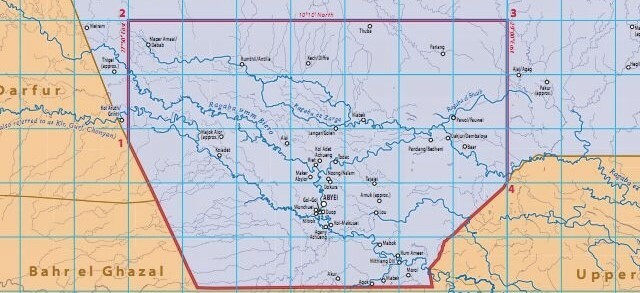I had a lengthy meeting today morning [Wednesday] with Dr. Riek Machar, the First Vice President of the Republic of South Sudan in the presence of Mrs Nyenagwuek Kuol to discuss some of the twisted facts about the Abyei Box. President Salva Kiir appointed in 2008 Dr. Riek Machar and me as co-agents and other members to represent South Sudan and the SPLM at the International Abyei Boundaries Arbitration Tribunal in the Hague, the Netherlands. This came as a result of the refusal of the Islamic regime of Bashir to recognize the final and binding report of the Abyei Boundaries Commission (ABC) and its call to resort to a final and binding international arbitration.
The process took almost nine months and it involved a lengthy and serious litigation process regarding social, historical, and legal facts about the Abyei Area and the participation of representatives of communities neighboring the Ngok Dinka of Abyei including Twic. The final award declared in July 2009 by the International Tribunal defines the area of the nine Ngok Chiefdom transferred in 1905 from Bahr el Ghazal province in Southern Sudan to Kordofan province in northern Sudan with the map of the Abyei Area attached with the final award. This map of the Abyei area provided by the Permanent Court of Arbitration in the Hague has become known as the Abyei Box (see the map).
The final award of the Tribunal including its map (Abyei Box) was approved immediately after the ruling by the then Presidency of Sudan consisting of Bashir, the then president of Sudan, President Salva Kiir, the then first vice president of Sudan, and the president of Southern Sudan, and Ali Osman, the then vice president of Sudan as well as the then government of Southern Sudan. Based on the approval of the award of the Tribunal, a republican decree was issued by Bashir for the establishment of the Abyei Administrative Area as per the provisions of the 2005 Comprehensive Peace Agreement (CPA) with its boundaries as defined by the Tribunal, the Abyei Box.
The 2011 Transitional Constitution of the new state of South Sudan in its Article 1 (2) defines the territory of the Republic of South Sudan to comprise all lands and air space that constituted the three former Southern Provinces of Bahr el Ghazal, Equatoria, and Upper Nile in their boundaries as they stood on January 1, 1956, and the Abyei Area (Abyei Box), the territory of the nine Ngok Dinka chiefdoms transferred from Bahr el Ghazal Province to Kordofan Province in 1905 as defined by the Abyei Arbitration Tribunal Award of July 2009 in the event that the resolution of the final status of the Abyei Area results in the Area becoming part of the Republic of South Sudan.
Also, Article 97 (4) of the 2011 Transitional Constitution of South Sudan clearly states that “Pending a final solution on its status, Abyei Area, the territory of the nine Ngok Dinka chiefdoms transferred from Bahr el Ghazal Province to Kordofan Province in 1905 as defined by the Abyei Arbitration Tribunal Award of July 2009 (Abyei Box), is accorded a special administrative status under the Office of the President of the Republic of South Sudan and the members of the nine Ngok Dinka Chiefdoms of Abyei Area shall have an inalienable right to enjoy South Sudanese citizenship and nationality and all rights and freedoms guaranteed by this constitution”. Based on these constitutional provisions, H.E. Salva Kiir Mayardit, the President of the Republic of South Sudan, established the Abyei Special Administrative Area with a presidential decree that defines the boundaries of Abyei Special Administrative Area (Abyei Box) as per the International Arbitration Tribunal Award.
Also, the Status of Force Agreement (SOFA) signed by the Republic of South Sudan (the host country) and the United Nations in November 2012 and by the Republic of Sudan (the host) and the United Nations in October 2012 concerning the status of the United Nations Interim Security Force for Abyei (UNISFA) recognizes the Abyei Box as the area of operations for the UNISFA. So, the Abyei Box is recognized not only by the two countries but also by the United Nations.
We agreed with Dr. Riek Machar on the need to create awareness about the Abyei Box as it is based on the legal award and ruling of the International Arbitration Tribunal and not created by any individual or individuals. Importantly, the Abyei Box is legally recognized in the Constitution of the Republic of South Sudan the Constitution of the Republic of Sudan, and the United Nations as well. The issue of the border between the Ngok Dinka of Abyei and Twic has never been a problem and if it exists as claimed by some individuals it could be resolved amicably and through traditional dispute resolution mechanisms or resort to a competent court of law.
Luka Kuol (PhD) is an adjunct professor at the University of Juba. He was previously a professor of practice for Security Studies at Africa Center for Strategic Studies (ACSS) at US National Defense University.
The views expressed in ‘opinion’ articles published by Radio Tamazuj are solely those of the writer. The veracity of any claims made is the responsibility of the author, not Radio Tamazuj.




